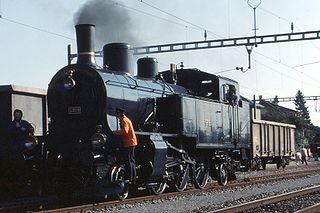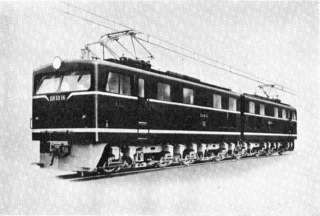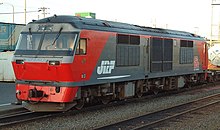
A locomotive or engine is a rail transport vehicle that provides the motive power for a train. If a locomotive is capable of carrying a payload, it is usually rather referred to as a multiple unit, motor coach, railcar or power car; the use of these self-propelled vehicles is increasingly common for passenger trains, but rare for freight trains.

An electric locomotive is a locomotive powered by electricity from overhead lines, a third rail or on-board energy storage such as a battery or a supercapacitor. Locomotives with on-board fuelled prime movers, such as diesel engines or gas turbines, are classed as diesel-electric or gas turbine-electric and not as electric locomotives, because the electric generator/motor combination serves only as a power transmission system.
In railway engineering, the term tractive effort describes the pulling or pushing capability of a locomotive. The published tractive force value for any vehicle may be theoretical—that is, calculated from known or implied mechanical properties—or obtained via testing under controlled conditions. The discussion herein covers the term's usage in mechanical applications in which the final stage of the power transmission system is one or more wheels in frictional contact with a railroad track.
The UIC classification of locomotive axle arrangements, sometimes known as the German classification or German system, describes the wheel arrangement of locomotives, multiple units and trams. It is used in much of the world, notable exceptions being the United Kingdom, which uses a slightly simplified form of UIC, and in North America, where the AAR wheel arrangement system is used to describe diesel and electric locomotives. In North America, the Whyte notation is only used for steam locomotives.
A number of different numbering and classification schemes were used for locomotives and multiple units operated by British Railways (BR), and this page explains the principal systems. This section also covers the post-privatisation period, as the broad numbering and classification arrangements have not altered since the break-up of BR.

Prima is a family of railway diesel and electric locomotives built by Alstom. Manufacture of the type commenced in the late 1990s. By 2008, Alstom had reportedly sold 1,750 Prima locomotives. The second generation Prima II was launched in 2009. The Prima H3 diesel/battery hybrid locomotive was launched in 2013.
PKP classification system is a system of assigning letters and numbers to series and individual locomotives used by the PKP - Polish national railroad operator.

Alstom Traxx is a modular product platform of mainline diesel-electric and electric locomotives. It was produced originally by Bombardier Transportation and later Alstom, and was built in both freight and passenger variants. The first version was a dual-voltage AC locomotive built for German railways from the year 2000. Later types included DC versions, as well as quadruple-voltage machines, able to operate on most European electrification schemes: 1.5/3.0 kV DC and 15/25 kV AC. The family was expanded in 2006 to include diesel-powered versions. Elements common to all variants include steel bodyshells, two bogies with two powered axles each, three-phase asynchronous induction motors, cooling exhausts on the roof edges, and wheel disc brakes.
The different railway companies in Germany have used various schemes to classify their rolling stock.

For more than a century, the Swiss locomotive, multiple unit, motor coach and railcar classification system, in either its original or updated forms, has been used to name and classify the rolling stock operated on the railways of Switzerland. It started out as a uniform system for the classification and naming of all rolling stock, powered and unpowered, but had been replaced and amended by the UIC classification of goods wagons.
The DRG locomotive classification system was developed by the German Imperial Railway Company or Deutsche Reichsbahn-Gesellschaft (DRG), which was formed in 1924 following the merger of the German state railways (Länderbahnen) in 1920. A common classification and numbering scheme was needed in order to organise effectively the four hundred or so different steam locomotive classes taken over from the state railways, as well as new locomotives. This process lasted until 1926. Only then was the final renumbering plan fixed.

The DR locomotive classification scheme in East Germany in the initial post-war period used the DRG system, consisting of a class number (Baureihennummer) followed by a serial number (Ordnungsnummer). With the introduction of computerised (EDP) numbers in 1970 as part of the UIC framework, the system was fundamentally changed for the first time.

The EH10 class of electric locomotives were Bo′Bo′+Bo′Bo′ wheel arrangement two-unit DC freight locomotives operated by Japanese National Railways (JNR) in Japan from 1954 until 1982.

The Class ED76 (ED76形) is a Bo-2-Bo wheel arrangement AC electric locomotive type operated on passenger and freight services in Japan since 1965, originally by Japanese National Railways (JNR), and later by Hokkaido Railway Company, Kyushu Railway Company and Japan Freight Railway Company. As of 1 April 2016, just 10 locomotives remained in service, all operated by JR Freight.

The Kolomna Locomotive Works is a major producer of railway locomotives as well as locomotive and marine diesel engines in Russia. The plant started production in 1869 with a freight steam locomotive, one of the first in Russia. In the Russian Empire, Kolomna was one of the few producers in Russia. During this period, 139 types of steam locomotives were designed. As of 2015, the company is now a part of Transmashholding.

The Class ED79 (ED79形) was a Bo-Bo wheel arrangement AC electric locomotive type operated on passenger and freight services in the north of Japan from 1986, originally by Japanese National Railways (JNR), and later by Hokkaido Railway Company and Japan Freight Railway Company until 2016.

The Class ED73 (ED73形) was a Bo-Bo wheel arrangement AC electric locomotive type operated by Japanese National Railways (JNR) in Kyushu, Japan, between 1962 and the 1980s.

The Class EF70 (EF70形) is a Bo-Bo-Bo wheel arrangement AC electric locomotive type operated by Japanese National Railways (JNR) in Japan from 1961 until the 1980s. 81 locomotives were built by Hitachi and Mitsubishi between 1961 and 1965.

Rigid-framed electric locomotives were some of the first generations of electric locomotive design. When these began the traction motors of these early locomotives, particularly with AC motors, were too large and heavy to be mounted directly to the axles and so were carried on the frame. One of the initial simplest wheel arrangements for a mainline electric locomotive, from around 1900, was the 1′C1′ arrangement, in UIC classification.






















